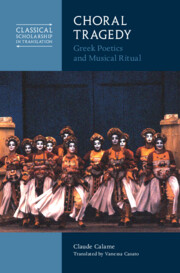Book contents
- Choral Tragedy
- Classical Scholarship in Translation
- Choral Tragedy
- Copyright page
- Dedication
- Contents
- Foreword
- Preface to the English Edition
- Note on the Translations
- Methodological Prelude
- Chapter 1 The Essence of ‘The Tragic’
- Chapter 2 Tragedy, Cult and Ritual
- Chapter 3 Choral Polyphonies and Tragedy
- Chapter 4 Aeschylus’ Persians
- Chapter 5 Euripides’ Hippolytus
- Chapter 6 Sophocles’ Oedipus Tyrannus
- Chapter 7 Poets, Tragic Diction and Tragic Fiction
- Bibliography
- Index of Names
- Subject Index
Chapter 4 - Aeschylus’ Persians
Questioning Choral Identity
Published online by Cambridge University Press: 25 April 2024
- Choral Tragedy
- Classical Scholarship in Translation
- Choral Tragedy
- Copyright page
- Dedication
- Contents
- Foreword
- Preface to the English Edition
- Note on the Translations
- Methodological Prelude
- Chapter 1 The Essence of ‘The Tragic’
- Chapter 2 Tragedy, Cult and Ritual
- Chapter 3 Choral Polyphonies and Tragedy
- Chapter 4 Aeschylus’ Persians
- Chapter 5 Euripides’ Hippolytus
- Chapter 6 Sophocles’ Oedipus Tyrannus
- Chapter 7 Poets, Tragic Diction and Tragic Fiction
- Bibliography
- Index of Names
- Subject Index
Summary
Let us begin by looking at a tragedy that is largely choral. Aeschylus’ Persians was staged at the Great Dionysia in 472, only one year after the Battle of Salamis, where the Athenian fleet had defeated Xerxes’ armada. The Great King had invaded continental Greece, and on reaching Athens had set fire to the Acropolis and destroyed the temple of its tutelary deity Athena, the Old Parthenon. Aeschylus’ choregos was none other than Pericles. Here we follow the dramatic – and choral – unfolding of this tragedy whose action takes place in Susa, the capital of Persia.
- Type
- Chapter
- Information
- Choral TragedyGreek Poetics and Musical Ritual, pp. 93 - 111Publisher: Cambridge University PressPrint publication year: 2024

